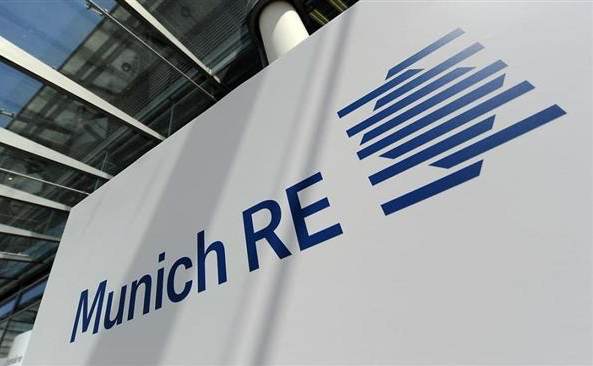 02-03-2020
02-03-2020
Munich Re’s P&C underwriting falls to technical loss on catastrophes

 Insurance Alertss
Insurance AlertssMunich Re’s P&C underwriting falls to technical loss on catastrophes
Property and casualty reinsurance underwriting fell to a technical loss for Munich Re, as the impacts of major catastrophe events drove the units combined ratios higher for the fourth-quarter and full-year of 2019.
Munich Re reported its full-year 2019 results this morning, comfortably beating its forecast guidance by EUR 200 million to deliver EUR 2.7 billion in profit. Performance was strong across the business, especially in investment return. But the property and casualty reinsurance suffered from the impacts of significant catastrophe and man-made loss events during the year.
While overall profits for the P&C reinsurance business rose significantly to EUR 1.532 billion, up on 2018’s EUR 1.135 billion, this was assisted by a huge release of reserves amounting to EUR 1.154 billion during the year. By reserving cautiously, Munich Re continues to enable itself to deliver these reserve releases in order to swell profits during periods of heavier catastrophe activity, moderating the impacts to its shareholders and delivering stronger profits as a result.
Also assisting the P&C reinsurance divisions profits were the investment result, which was significantly higher than in 2018. The benefits of reserve releases and investment result seem to have driven the P&C reinsurance profit figure for Munich Re, helping to erase the impact of less profitable technical underwriting. 2019 has again proven a high year of catastrophe and major loss activity for Munich Re, with the reinsurance firms combined ratio higher than the prior year and also higher in the fourth-quarter as well.
Munich Re has reported a P&C reinsurance combined ratio for the full year of 101% (up on 2018’s 99.4%) of net earned premiums, while in Q4 2019 it rose to 112.5% (up on Q4 2018’s 105.1%). It’s perhaps a little surprising that Q4 saw such a rise in combined ratio, given the prior year saw the California wildfires.
But it’s likely Munich Re has suffered hits from numerous events in the final quarter of 2019, including typhoon Hagibis, the wildfires in Australia, as well as other severe weather and flooding events around the globe.
Major losses amounted to a huge EUR 3.124 billion for the full-year (up on 2018’s EUR 2.152bn), while the fourth-quarter saw major losses of EUR 1,462 billion ( up on 2018’s EUR 886m), including gains and losses from prior year events. Signalling just how impactful a year 2019 has been, Munich Re’s major-loss expenditure corresponds to 15.2% (2018 was 11.6%) of net earned premiums, so well above the long-term average expected value of 12%.
The reinsurance firm reported some EUR 1.071 billion of man-made losses in 2019 (2018 saw EUR 896m), with aviation, space and fire losses a key driver of these claims for the firm. Natural catastrophes drove EUR 2.053 billion of losses in 2019, up significantly on 2018’s EUR 1.256 billion.
Munich Re said that the most expensive natural catastrophe losses for the company in 2019 were typhoon Hagibis at EUR 780 million and typhoon Faxai at EUR 530 million. As ever, it’s impossible to look-through and see how supportive third-party reinsurance capital and investors backing Munich Re’s sidecars and quota shares have been in paying these claims, or not.
Munich Re also provided an update on the reinsurance renewals at January 1st, saying that it grew premiums written by 4.4% to reach EUR 10.6 billion, with around half of its P&C reinsurance business renewed.
“Price trends varied among the different market segments in line with different claims experience. In turn, prices rose – considerably in some instances – for reinsurance cover in regions and classes of business with high claims experience, with the Caribbean and aviation and space being two examples. Conversely, prices remained mostly stable in regions and classes of business with low claims experience – such as Europe and Asia (excluding Japan),” the company explained.
Munich Re said it has withdrawn from some policies in the United States where it does not feel rates have moved sufficiently and prices failed to reach its expectations. Overall, Munich Re said that prices for its portfolio increased by 1.2% risk-adjusted.
Looking ahead, Munich Re said that it expects continued improvements in market conditions, with the next renewal rounds in April and July expected to see prices increase, “as treaties in regions with significant claims experience in 2019, such as Japan, will be up for renewal.” Munich Re has continued to expand its business throughout 2019, taking advantage of these price increases to build a larger and likely better performing book of business with greater profit potential (depending on loss activity of course).
Reinsurance premiums written rose by 8.1% during the last year, including in the P&C division. For 2020 the reinsurance company expects to grow premiums slightly during the year, to around EUR 52 billion across the business, which is roughly a EUR 500 million increase.
While the targeted profit for 2020 now stands at EUR 2.8 billion, so higher than was achieved in this calendar year, with EUR 2.3 billion delivered by the reinsurance unit. Munich Re also aims to improve the combined ratio for its P&C reinsurance division to 97% for 2020, although part of this is due to a change in cost-allocation that will lower it by 0.5% to 1%.
The reinsurer continues to demonstrate its levers, with reserve releases and investments being key drivers of profit once again. This strategy, of conservative reserving and releases when losses are higher, has served Munich Re well, alongside a robust investment portfolio it has become an increasing engine of profit for the company, when underwriting suffers due to global loss activity.
The one unknown (or unknowable) with Munich Re is how much its business could be improved by the digitisation efforts it is undertaking. At some point these significant expenditures must begin to be evidenced, in the results in terms of greater efficiencies and higher profits. So far, it’s very hard to see a consistent improvement in any reinsurance business due to digitisation, Munich Re included. But the money being spent on such activities has to deliver clearer benefits in time and we expect the larger players (like Munich Re) will begin to promote gains made in the next year or two as these initiatives finally bed in and begin to deliver something positive. As if digitalisation fails to deliver, shareholders and analysts will ask a lot of questions as to why.
For Munich Re the gains that should be made, if digitalisation budgets have been well-spent, could be really significant, so it is going to be interesting to see how that plays out over the coming years. Commenting on the 2019 results, CEO Joachim Wenning said, “A higher dividend, new share buy-back programme, and profits beating the guidance: Munich Re delivers. On our journey to make Munich Re more profitable, more lean and more digital, we took a great step forwards in 2019. With this strategic progress, I am confident that we will reach the profit target of €2.8bn for 2020 that we set out in our multi-year ambition for 2018–2020.”
Source: Artemis

For online registration follow the link